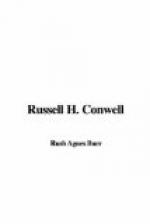When that old guide had told me that very sad story, he stopped the camel I was riding and went back to fix the baggage on one of the other camels, and I remember thinking to myself, “Why did he reserve that for his particular friends?” There seemed to be no beginning, middle or end—nothing to it. That was the first story I ever heard told or read in which the hero was killed in the first chapter. I had but one chapter of that story and the hero was dead. When the guide came back and took up the halter of my camel again, he went right on with the same story. He said that Al Hafed’s successor led his camel out into the garden to drink, and as that camel put its nose down into the clear water of the garden brook Al Hafed’s successor noticed a curious flash of light from the sands of the shallow stream, and reaching in he pulled out a black stone having an eye of light that reflected all the colors of the rainbow, and he took that curious pebble into the house and left it on the mantel, then went on his way and forgot all about it. A few days after that, this same old priest who told Al Hafed how diamonds were made, came in to visit his successor, when he saw that flash of light from the mantel. He rushed up and said, “Here is a diamond—here is a diamond! Has Al Hafed returned?” “No, no; Al Hafed has not returned and that is not a diamond; that is nothing but a stone; we found it right out here in our garden.” “But I know a diamond when I see it,” said he; “that is a diamond!”
Then together they rushed to the garden and stirred up the white sands with their fingers and found others more beautiful, more valuable diamonds than the first, and thus, said the guide to me, were discovered the diamond mines of Golconda, the most magnificent diamond mines in all the history of mankind, exceeding the Kimberley in its value. The great Kohinoor diamond in England’s crown jewels and the largest crown diamond on earth in Russia’s crown jewels, which I had often hoped she would have to sell before they had peace with Japan, came from that mine, and when the old guide had called my attention to that wonderful discovery he took his Turkish cap off his head again and swung it around in the air to call my attention to the moral. Those Arab guides have a moral to each story, though the stories are not always moral. He said had Al Hafed remained at home and dug in his own cellar or in his own garden, instead of wretchedness, starvation, poverty and death in a strange land, he would have had “acres of diamonds”—for every acre, yes, every shovelful of that old farm afterwards revealed the gems which since have decorated the crowns of monarchs. When he had given the moral to his story, I saw why he had reserved this story for his “particular friends.” I didn’t tell him I could see it; I was not going to tell that old Arab that I could see it. For it was that mean old Arab’s way of going around a thing, like a lawyer, and saying indirectly what he did not dare say directly, that there was a certain young man that day traveling down the Tigris River that might better be at home in America. I didn’t tell him I could see it.




